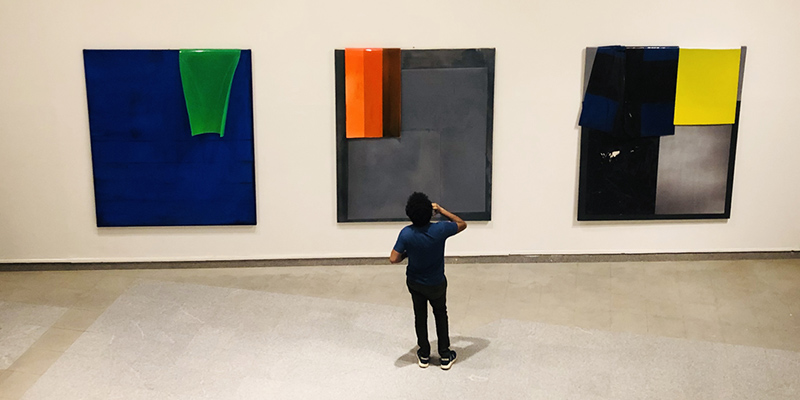UniSA visual artist represented on world stage at Cairo Biennale
By Clancy Larsen
 ART AND DESIGN Works by Christian Lock on exhibition in Cairo.
ART AND DESIGN Works by Christian Lock on exhibition in Cairo.Contemporary painter and UniSA studio educator, Christian Lock, returns from Egypt this month where festivities are underway in a hallmark celebration of Egypt’s 13th iteration of the international Cairo Biennale.
Lock was one of 74 artists from 52 countries invited to take part – exhibiting as Australia’s sole representative.
 The Palace of Arts in Cairo.
The Palace of Arts in Cairo.Following a nine-year hiatus due to the region’s now infamous political instability, the Cairo Biennale’s return to the world stage represents a concerted effort by the Egyptian government to reposition arts and culture as a development priority in the region.
A historical hotbed of arts and culture – often referred to as the cradle of civilisation – Egypt’s recent political past threatened to entirely eradicate the creative freedom of academics, artists and philosophers.
The Arab Spring of 2011 and the resultant military coup of 2013 saw a violent loss of life for pro-democracy protestors across the region, and Cairo’s Tahrir Square remains a symbol of the beginning of a series of large-scale popular protests that have taken place in the years since.
 Hybrid children watch the sea
Hybrid children watch the sea“The Arab Spring saw academics, artists, philosophers rise up against an ever autocratic conservative government opposing creative freedom which saw many thinkers and creatives lose their lives,” Lock says. “Some artists participating in the Biennale lost their friends during acts of violence inflicted by government officials during the uprising ... and bravely return in 2019 to exhibit.”
He says the theme of this year’s Biennale – Eyes East Bound – acknowledges the region’s tumultuous recent past.
“Artistic Director Ehab Ellaban asked artists when creating new work for the 13th Cairo Biennale to look beyond the current political discourse and scrutinising focus on the East and draw on the ‘wealthy cultural heritage’ built over centuries which has influenced the world’s modern cultures,” Lock says.
As one of those participating artists, Christian Lock had the opportunity to travel to Egypt to observe these traditions firsthand. Lock’s journey to Cairo began in 2014 when he exhibited at Art Dubai, a widescale visual art fair featuring a curated exhibition for international artists. It was there that his work first caught Ehab Elleban’s eye. Lock was approached to participate in the next iteration of the Cairo Biennale, then scheduled for 2015. This event was not to take place because of continued political upheaval, but the connection was made, and in November 2018 Lock was once again approached to participate, becoming the first artist selected to return the Biennale to Egypt.
 Third Encounter
Third EncounterLock’s experiences in Cairo opened his eyes to the potential of the region’s artistic development despite its reputation.
“[Artistic director Ehab Ellaban] fiercely preserved the creative integrity of each respective artist,” he says. “The result was strong discourse between disciplines.
“The generosity afforded to all participating artists, their families and friends by the Egyptian Government was extraordinary.”
Lock’s career as a contemporary practitioner and educator spans 20 years and multiple institutions. He completed a Bachelor of Visual Arts (Honours) in 2001 and a Masters of Visual Arts in 2006 at UniSA and attended Parsons Art and Design School in New York City as a visiting postgraduate scholar in 2014. He has exhibited regularly in galleries across Australia and internationally including Greenaway Art Gallery, Adelaide, ACE Open, Adelaide, and Chasm Gallery, New York. His paintings are held in multiple public and private collections including Artbank, Sydney, and the Art Gallery of South Australia.
The 13th Cairo Biennale saw Egypt open its doors once again to the contemporary art world amidst ongoing political unrest.
Other Stories
- A midnight snack might be the key to working overnight
- Memory warning to those wanting to spice up their lives
- Study indicates causal link between obesity and multiple diseases
- Dragonflies are helping make driverless cars safer
- From the Vice Chancellor
- Achievements and Announcements
- Sixteen images that will change how you view research
- Technology preventing hospital falls explained through animation
- Refurbished spaces for Aboriginal students open at City East and Magill
- Healthy lifestyle may counteract genetic risk of dementia
- Video: See highlights from the first six months of 2019
- UniSA visual artist represented on world stage at Cairo Biennale
- Students and staff to provide a ‘hand up’ to help the homeless
- The latest books from UniSA researchers
- UniNationals and Crows lunch




